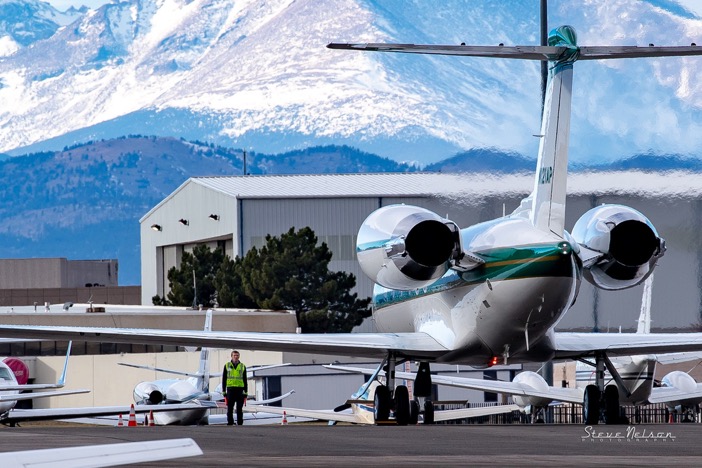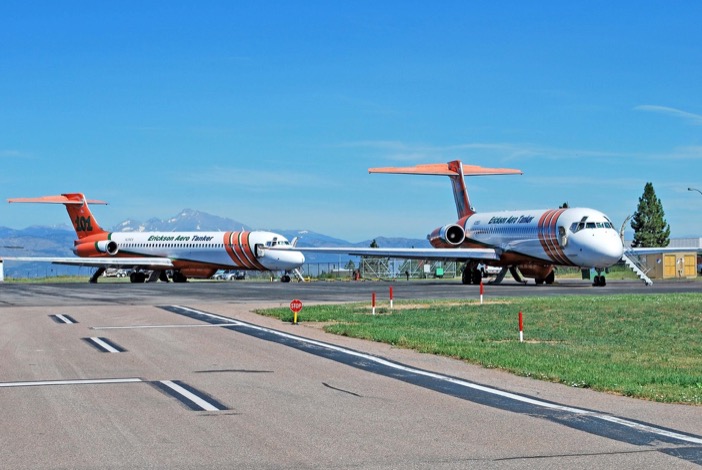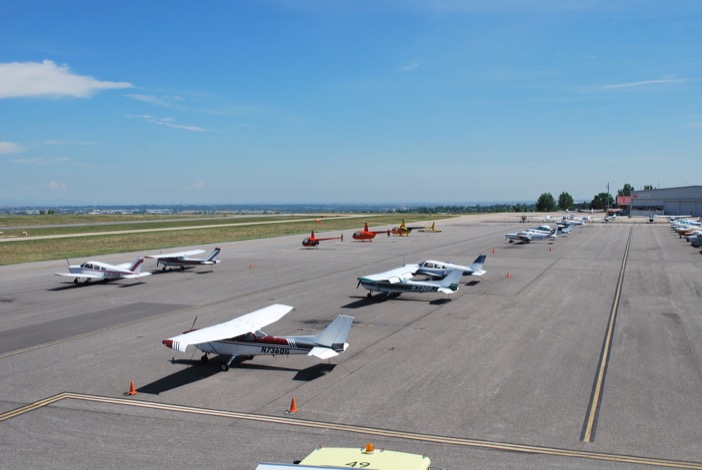by David Hughes
A legislative movement afoot in the USA that aims to shift the control of noise at general aviation airports from federal to local control has some aviation groups alarmed.
The latest bill introduced in the US House of Representatives by Rep. Joe Neguse (D-Boulder) comes out of Colorado. Airports on the front range, in the shadow of the Rockies have been enjoying a booming economy. An amendment to enact local control of noise at general aviation airports was attempted by the FAA Reauthorization Act of 2017 but did not pass. This so-called “Polis Amendment” was offered by then Rep. Jared Polis representing citizens in Longmont, Colorado protesting against airport noise from a skydiving operation. Polis is now governor of Colorado.
The Aircraft Noise Reduction Act introduced by Neguse in December 2019 would allow the owner or operator of a general aviation airport to restrict the number and type of aircraft operations for compensation or hire occurring at the airport, including flights originating or landing at the airport, and the dates and times of such operations. The amendment requires that the airport takes into account input from local communities when making decisions.
Patchwork regulation
The Aircraft Owners and Pilots Association (AOPA) says that the laws and regulations currently in place, including the Aircraft Noise and Capacity Act of 1990, have proven successful for several decades. AOPA’s senior director of legislative affairs Scott Verstandig says he does not see support in Congress for the new bill, which would overturn the long established process that involves an airport working with the FAA if it wants to address noise issues.
“If this bill becomes law it would create a patchwork of conflicting local regulations, jeopardize safety and create an economic burden on the aviation community,” says Mike Ginter, AOPA’s vice president of airports and state advocacy. At the Experimental Aircraft Association, director of communications Dick Knapinski says that “it would be more daunting for a pilot to fly to three different airports with three different sets of rules. That would be completely confusing for pilots and bring economic harm.”

The proposed changes could affect the entire national airspace system, according to Alex Gertsen, NBAA director of airports and ground infrastructure. “If you restrict pilots at general aviation airports, they may all go to air-carrier airports. This would take away the reliever role the these smaller airports now play,” he says.
AOPA and NBAA were co-signatories on a letter opposing the new airport noise bill. The letter says that the legislation would result in “undercutting the utility and safety of thousands of airports across the nation and reversing course on the need to regulate aviation matters at the federal level, which Congress has recognized since the 1920s”.
Existing federal regulation has resulted in “tremendous noise reduction with the number of people exposed to significant levels of aircraft noise in the USA dropping by 94% since the late 1970s, even as enplanements more than quadrupled”.
Complaint escalation
The NBAA/AOPA letter is signed by seven other aviation groups, representing most of the industry including commercial, regional and cargo airlines. Urgency exists in the aviation sector to get on the record opposing this action right away.
“Thousands of bills are introduced and few of them make it anywhere,” said Tom Charpentier, government relations director at the Experimental Aircraft Association (EAA), one of the co-signatories of the letter. “But a measure like this could be scooped up into an omnibus bill, so it is important to demonstrate early there is significant opposition.”
Knapinski said that noise abatement procedures can reduce safety when the shape and size of the landing pattern is altered, or arrival and departure paths are restricted. The EAA does not believe that local communities should be allowed to set their own standards on something that is a federally funded and supported activity and which is part of the national infrastructure.

The National Air Transportation Association (NATA) takes issue with the bill for “unfairly targeting” operations for compensation or hire when the owner or operator of a personal aircraft could operate the same type of aircraft at the airport in question without restriction. NATA’s vice president of government and public affairs Jonathon Freye says, “As the voice of the air charter industry, NATA strongly opposes this bill.” It was prepared without any dialogue with the aviation industry to explore the noise issue and solutions that would be acceptable to all concerned.
Freye believes there is a national trend of escalating noise complaints from communities near airports as legislators respond to their constituents’ complaints. Neguse and all of the representatives co-sponsoring the noise bill are members of the Quiet Skies Caucus, which has 44 Democrats and one Republican as members.
The National Quiet Skies Coalition was formed to support communities that have been adversely impacted by the FAA’s NextGen air traffic modernization effort. The FAA redesigned hundreds of arrival, approach and departure flight paths at major airports. The perceived noise impact of these new procedures on residents near airports have prompted many lawsuits. The Quiet Skies coalition has about 50 affiliated groups, located in various communities from New York to California and as far west as Hawaii.
“It is very common at airports with a significant increase in noise complaints that the majority of those complaints came from a minority of individuals who were repeatedly reporting,” says Freye. “We believe that most localities understand that activity at the airport translates directly into local investment, jobs and tax revenues.”
Freye also believes that local complaints reflect “broader anti-aviation sentiment, like that we’ve seen in communities like Santa Monica and East Hampton”. (see below Santa Monica fight not over).
Complaints are on the rise at Rocky Mountain Metropolitan Airport (BJC) though they come from a “tiny fraction” of the residents who are a “highly energized group,” Freye says. “This is an unfortunate trend that is becoming more common around the nation.” Rocky Mountain Metropolitan Airport is half-way between Denver and Boulder and about 13 miles away from each city.
“The bill is bad for business and it isn’t safe. Right now we have the safest airspace and aviation system in the world and the reason is we have federal control,” said Paul Anslow. Rocky Mountain Metropolitan Airport’s manager.
Federal oversight has multiple checks and balances while local control could be chaotic and dangerous, he believes, but ultimately aviation groups will be able to argue effectively against the proposed scheme.
Student noise
Meanwhile, a pilot shortage is pumping up flight school enrollments by 15 to 20% a year. Student pilots spend a lot of time in local patterns doing touch and go’s. Anslow said the four flight schools based at Rocky Mountain Airport draw most of the noise complaints. Nearby residents hate the “constant droning” of these types of flight operations, he says. A student pilot often makes a half dozen trips around the pattern flying touch and go’s.
About 25 miles north of Rocky Mountain Airport is Vance Brand Airport in Longmont, Colorado where there are two flight schools. With about 85,000 operations a year it is a busy non-towered airport. Airport manager Dave Slayter said sky diving aircraft create a constant drone in terms of noise as they climb out several miles to the south up to altitudes of 5,000 to 18,000ft. After sky divers jump out, the pilots race back down to the airport to pick up the next group. “Noise is a big deal in this area of Colorado right now and not just at general aviation and towered airports but also at Denver,” says Brand.

The Colorado Aviation Business Association opposes the bill. Chris Swathwood, chairman of the board of trustees of the association, believes noise is a very localized issue, but that the proposed legislation would affect every general aviation airport in the USA, even though it is being prompted by a small population of unhappy residents near Colorado airports.
Santa Monica Airport fight not over
Aviation groups are battling to keep Santa Monica Airport in California open and are hoping that a change in rules for electing the city council will
aid their cause.
In 2017 the city government obtained a consent decree from the FAA, ending its lawsuit against the federal agency. The agreement does not allow the airport to be closed until January 1, 2029. The city government says it has not taken any action or officially decided to close the airport, which it can now do on its own. The city entered the consent decree because it wants to mitigate noise and other adverse impacts on communities near the airport and to settle pending litigation. All but one lawsuit contesting the validity of the agreement have been unsuccessful.

Opponents are convinced that the city intends to close the airport. “The Aircraft Owners and Pilots Association will never give up on Santa Monica,” said Jim Coon, AOPA’s senior vice president of government affairs. “The residents of Santa Monica need to wake up and replace the current misguided city council, which has clearly folded to land developers,”
he says.
Ed Story, a pilot and member of the board of directors of the pro-airport Santa Monica Airport Association believes there are only about 200 people who live near the airport who want to shut it down. One neighborhood successfully sued the city to change how the city council is elected, so that districts farther from the airport are represented. Noise complaints focus on business jets, but the city has torn up 1,500ft of the 5,000ft runway. Now the largest jet that can operate there is a Gulfstream G280 instead of the previous Gulfstream IV size.
Alex Gersten, the National Business Aviation Association’s director of airports and ground infrastructure, says that other neighborhoods not being represented now may appreciate the potential future value of the airport. He says urban air mobility developers, such as Uber and Amazon, are interested in using the airport for air taxis.
Other Santa Monica Airport supporters say that electric aircraft will reduce noise at the airport this decade. They also question the city’s motivations for its closure, pointing to the value of the 227 acres of land at the site and that if there is no airport, height restrictions can be lifted on buildings near the airport.
Santa Monica Airport is used by the rich and famous. Jeff Bezos recently bought a US$165 million home in Beverly Hills around seven miles from the airport. His partner Lauren Sanchez is a helicopter pilot who lives nearby and her business Black Ops Aviation is based at Santa Monica Airport. She flies helicopters with cameras to make movies. Harrison Ford also flies from the airport.





